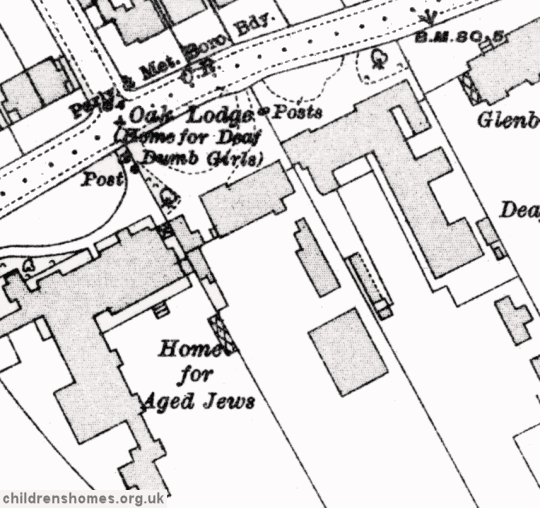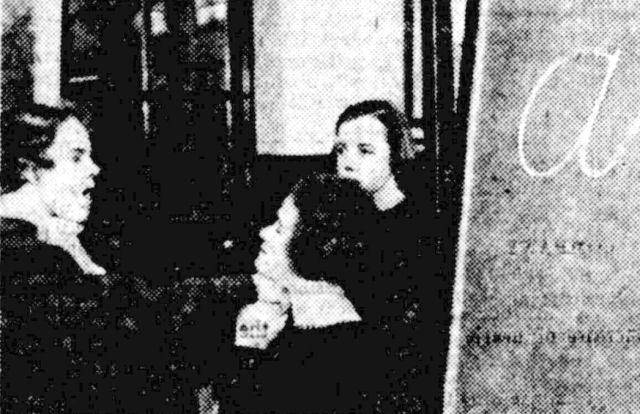LCC School for Deaf and Dumb Girls, Oak Lodge, Wandsworth Common, London
The London County Council Residential School for Deaf and Dumb Girls, otherwise known as Oak Lodge School, was opened on 28 August 1905 at 103 Nightingale Lane, Wandsworth Common. The school, based in a large old house, could accommodate 33 boarders and up to 39 day pupils, aged from 13 to 17 years.
The School site is shown on the 1913 map below.

LCC School for the Deaf and Dumb Girls site, Wandsworth Common, c.1913.

Teaching a pupil to sound a vowel at Oak Lodge School, Wandsworth Common.
The instruction at the school was based on the 'oral' system — teaching articulation and lip-reading rather than sign-language and finger-spelling.
In March 1927, a journalist wrote an account of a visit to the school:
It was a strange world into which I walked from Clapham the other afternoon.
Scene: An ordinary schoolroom. Girls in neat blue frocks were at drill. They numbered in “ones”and “twos,” looking into their partners' faces. They marched and turned, with their eyes the lips of their teacher. Every command she uttered was instantly obeyed.
Suddenly a curious thing happened. The voice ceased, but the drill went on. I looked round. No sound was coming from the teacher, but she was still moving her lips, issuing silent orders.
I had wondered what was the matter. The girls who were drilling had noticed difference at all.
For was at one the most remarkable places in London—the Oak Lodge Residential School for Deaf Girls.
“Now you would like see some dancing,” said the instructress, as if dancing was matter-of-fact accomplishment for deaf girls. Another mistress suit down piano and played Russian dance. Not a simple dance, by any means, but brisk affair, full of changes. The girls did it beautifully, keeping perfect time.
How was it done? I guessed one secret. “Yes,” said their teacher, “if you watch them closely you will notice they are counting; all the time.” But I was puzzled by the piano. The girls could not hear one note. Was it possible that some way the sound vibrations reached them?
Miss Hopson, the headmistress, smiled at my journalistic guesswork. “Oh. no. That's just fancy. That doesn't happen at all.” And she added, “Why not ask them?”
I beckoned to a girl. “Does the piano help you when you dance?” I asked. The question had to repeated. Perhaps I was not careful enough of my articulation the first time. The second time she understood, and answered, “No, we can't hear it.”
“Then why do you have it?” continued. Her answer was, “To make it seem more real.”
To show that the piano difference, they danced without it. This time it was folk-dance. It was more complicated still. It went on for more than three minutes, and the girls formed rings, twined in and out among one another, went through the most intricate evolutions. So far I could tell, they made not a single mistake.
The silence of it all was fantastic, unearthly. At one point, half way through, they clapped their hands in unison. The noise came as a shock. It made me realise that music in a picture theatre is not luxury but a necessity: a silent film would be unendurable.
These things were striking. But the manner in which these girls have been given the power of speech is more marvellous still. Think what it means. There are children who have never heard a sound in their lives. The roar of the streets, the band that goes past, the voices of their mothers and playmate — all are without meaning. Yet they learn to talk and to carry on a conversation with a normal person, just as if they themselves were normal.
“How am I different from you?” was a question asked by a visitor. A girl replied. “You understand what I am saying when my back is turned.”
All the girls have learned to speak at the various L.C.C. day schools for deaf children before they enter Oak Lodge at the age of 13: but a mistress was kind enough to show me how it is done.
The little ones have games which are breathing exercises in disguise: blowing up balloons, bursting paper bags. “They love that; the difficulty is to get enough bags” — although they miss the best part, the bang!
One day the teacher takes the child's hand and breathes: we breathe when we sound an aspirate. The child imitates, and the sound H is born. Thus the letter with which the deaf child begins is the one which with some Londoners is the last to be learned. Other simple sounds follow: WH, F, TH. All the time they are associated with the actual letters on the blackboard and the actual movements of the teacher's lips. The child learns simultaneously to speak, to read, and to understand what others are saying.
Vowels are harder. The first is “open A”: it is called AR. To make the child understand that this is more than breathing, and that the vocal chords must do their bit, the teacher presses her hand under the pupil's chin, and makes the pupil do the same to her.
Next, 00. Then what has already been taught combined: HA, THOO. And on. To teach a deaf child to speak takes about eight years. I heard three of the eldest girls recite Shakespeare, and thought of the skill and patience that lay behind their ability to speak at all.
Miss Hopsom told me that the object of Oak Lodge is to make these girls self-supporting members of the community. They stay until 16. Some learn laundry work, others dressmaking. They have a fully equipped laundry, “guaranteed not to fray collars,” and they reach great heights in the art of the needle. In the wooded grounds is a model cottage, where they are trained in the work an ordinary household, including the. care of baby. The baby is model too, clad in beautiful garments made by the girls, and lying ever still and quietly in a cot made by the brother school for deaf boys at Anerley. I need hardly say it is a doll.
And I ought to add that this little world, weird as it sometimes seemed, was evidently a happy one to those who lived in it. They were full of fun. I asked what they liked best on half-holidays. You will guess their answer: “Going to 'the pictures!'”
In 1955, the school became a day school. In 1957, the L.C.C. school for deaf boys at Anerley was closed and the boys joined the girls at Oak Lodge.
In 1965, the adjacent school for Jewish deaf children closed. It and Oak Lodge were then demolished and replaced by a new building, which retained the name Oak Lodge, which continues in operation today.
Records
Note: many repositories impose a closure period of up to 100 years for records identifying individuals. Before travelling a long distance, always check that the records you want to consult will be available.
- The
Ancestry UK
website has two collections of London workhouse records (both name searchable):
- The Find My Past website has workhouse / poor law records for Westminster.
- London Metropolitan Archives, 40 Northampton Road, London EC1R OHB.
Bibliography
- Higginbotham, Peter Children's Homes: A History of Institutional Care for Britain's Young (2017, Pen & Sword)
- Pritchard, D.G., Education and the Handicapped 1760-1960 (1963, Routledge & Kegan Paul)
- Watson, J, Instruction of the Deaf and Dumb (1809)
- Watson, Thomas J., A History of Deaf Education in Scotland 1760-1939 (Unpublished PhD Thesis, University of Edinburgh, 1949)
Links
Except where indicated, this page () © Peter Higginbotham. Contents may not be reproduced without permission.


